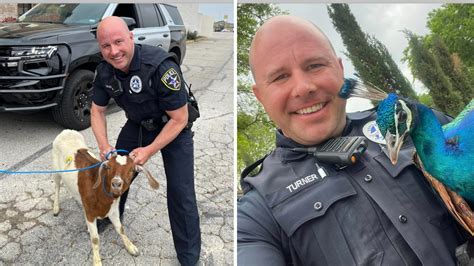
A Texas constable deputy’s efforts to reunite stray goats and dogs with their owners in Fort Bend County have unexpectedly turned him into a viral sensation, captivating audiences with his unorthodox methods and showcasing a lighter side of law enforcement.
Deputy Constable Chad Norvell of Precinct 1 has garnered widespread attention for his proactive approach to animal control, often personally rounding up wandering animals and posting images and videos on social media in an attempt to locate their owners. His posts, often humorous and engaging, have attracted a large following, earning him the moniker of the “goat and dog whisperer” by some online observers. Norvell’s work highlights the challenges of animal control in suburban and rural areas and the innovative ways law enforcement officers are using social media to connect with their communities.
Norvell’s approach is a departure from traditional animal control methods, which often rely on shelters or animal control services to handle stray animals. Instead, he utilizes social media platforms like Facebook and Nextdoor to directly engage with residents, sharing photos and descriptions of the found animals in the hopes of quickly reuniting them with their families. This strategy has proven remarkably successful, with many animals being claimed within hours of Norvell’s posts.
“It’s a lot easier to find the owner than it is to try to catch them and take them to the shelter,” Norvell explained in an interview. His approach is rooted in a desire to minimize stress for both the animals and their owners. Shelters can be overwhelming environments for animals, and the process of reclaiming a pet from a shelter can be time-consuming and costly for owners. By directly connecting with the community, Norvell bypasses these obstacles and streamlines the reunification process.
The viral nature of Norvell’s posts has not only helped reunite pets with their owners but has also raised awareness about responsible pet ownership. His posts often include gentle reminders about the importance of proper fencing, identification tags, and microchipping. By using his platform to educate the public, Norvell is working to prevent animals from becoming lost in the first place.
The positive response to Norvell’s work underscores the value of community policing and the importance of building relationships between law enforcement and the public. His actions demonstrate that law enforcement officers can play a vital role in addressing local issues and improving the quality of life for residents.
The success of Norvell’s methods has prompted other law enforcement agencies to consider adopting similar strategies. By leveraging the power of social media, these agencies can enhance their community outreach efforts, improve animal welfare, and foster stronger relationships with the people they serve.
The Rise of a Viral Sensation
Deputy Norvell’s journey to viral fame began with a simple desire to help lost animals. As a constable deputy, he often encountered stray animals while on patrol. Rather than simply calling animal control, he decided to take a more proactive approach. He would capture the animals, provide them with temporary care, and then post photos and descriptions on social media in an attempt to find their owners.
His first few posts generated a modest amount of interest, but it wasn’t until he began posting videos of his encounters with the animals that his popularity truly exploded. These videos, often featuring Norvell’s humorous commentary and genuine affection for the animals, resonated with viewers and quickly spread across social media platforms.
One video, in particular, featuring Norvell attempting to wrangle a group of goats, went viral, garnering millions of views and countless shares. The video showcased Norvell’s patience, good humor, and undeniable skill in handling the animals. It also highlighted the absurdity of the situation, with Norvell chasing goats through suburban streets while offering witty remarks.
“They’re surprisingly fast,” Norvell quipped in the video, as he attempted to corral the goats. “I didn’t realize I’d be spending my afternoon herding goats, but here we are.”
The video’s popularity led to media coverage from local news outlets, followed by national and international attention. Norvell was interviewed on television and radio, and his story was featured in newspapers and online publications around the world. He quickly became known as the “goat and dog whisperer,” a title he embraces with good humor.
The Challenges of Animal Control in Fort Bend County
Fort Bend County, located southwest of Houston, is a rapidly growing area with a mix of suburban and rural communities. This unique blend presents a number of challenges for animal control. The county’s diverse landscape includes residential neighborhoods, sprawling ranches, and undeveloped land, which can make it difficult to track and manage stray animals.
One of the biggest challenges is the lack of adequate fencing in some areas. Many residents, particularly in rural areas, rely on fences to contain their animals. However, these fences are not always well-maintained, and animals can easily escape. Additionally, some residents may not be aware of the importance of proper fencing or may simply neglect to repair damaged fences.
Another challenge is the increasing number of exotic animals being kept as pets in the county. In addition to dogs and cats, residents own a variety of animals, including goats, pigs, chickens, and even more exotic species like reptiles and birds. These animals can be more difficult to manage than traditional pets, and their escape can pose a risk to public safety.
The county’s animal control services are often stretched thin, particularly during peak seasons when the number of stray animals tends to increase. This can make it difficult for animal control officers to respond to every call in a timely manner.
Deputy Norvell’s proactive approach to animal control helps to alleviate some of the burden on the county’s animal control services. By personally rounding up stray animals and attempting to reunite them with their owners, he reduces the number of animals that end up in shelters and frees up animal control officers to focus on other priorities.
The Power of Social Media in Law Enforcement
Deputy Norvell’s success highlights the growing importance of social media in law enforcement. Social media platforms like Facebook, Twitter, and Instagram provide law enforcement agencies with powerful tools for communicating with the public, sharing information, and building relationships.
Social media can be used to disseminate information about crimes, missing persons, and other public safety concerns. It can also be used to solicit tips from the public and to gather evidence. In addition to these practical applications, social media can also be used to humanize law enforcement officers and to foster a sense of community.
By sharing photos and videos of their work, law enforcement officers can show the public that they are more than just enforcers of the law. They are also members of the community who care about the well-being of their neighbors. This can help to build trust and improve relationships between law enforcement and the public.
Deputy Norvell’s use of social media is a prime example of how these platforms can be used to achieve positive outcomes. His posts not only help reunite lost animals with their owners but also raise awareness about responsible pet ownership and promote a positive image of law enforcement.
The Importance of Responsible Pet Ownership
Deputy Norvell’s work also underscores the importance of responsible pet ownership. Many of the animals he encounters are stray because their owners have failed to take adequate precautions to prevent them from escaping.
Responsible pet ownership includes a number of key elements:
- Proper Fencing: Ensuring that fences are in good repair and capable of containing animals is essential. Fences should be regularly inspected and repaired as needed.
- Identification Tags: Animals should wear identification tags that include the owner’s name, address, and phone number. This makes it easier for anyone who finds a stray animal to contact the owner.
- Microchipping: Microchipping is a permanent form of identification that can help reunite lost animals with their owners even if they lose their collars and tags. A microchip is a small electronic device that is implanted under the animal’s skin. The microchip contains a unique identification number that can be read by a scanner.
- Regular Veterinary Care: Animals should receive regular veterinary care, including vaccinations and preventative treatments for parasites. This helps to keep them healthy and prevents the spread of disease.
- Training and Socialization: Animals should be properly trained and socialized to ensure that they are well-behaved and safe around people and other animals.
By taking these steps, pet owners can help prevent their animals from becoming lost or injured and can contribute to a safer and more harmonious community.
Community Policing in Action
Deputy Norvell’s actions exemplify the principles of community policing. Community policing is a philosophy of policing that emphasizes building relationships between law enforcement and the community. It involves working collaboratively with residents to identify and address local problems.
Community policing is based on the idea that law enforcement officers are most effective when they are seen as partners in the community, rather than simply enforcers of the law. By building trust and fostering relationships, law enforcement officers can gain valuable insights into local problems and can work with residents to develop solutions.
Deputy Norvell’s work is a perfect example of community policing in action. He is not only enforcing the law but also actively engaging with the community to address a local problem – stray animals. By using social media to connect with residents, he is building relationships and fostering a sense of community.
His efforts have been widely praised by residents, who appreciate his dedication and his willingness to go above and beyond the call of duty. His work demonstrates that law enforcement officers can play a vital role in improving the quality of life for residents and building stronger communities.
The Future of Animal Control
Deputy Norvell’s success has prompted many to consider the future of animal control. His methods offer a potential model for other communities looking to improve their animal control services. By leveraging the power of social media and embracing a community-oriented approach, law enforcement agencies can enhance their outreach efforts, improve animal welfare, and foster stronger relationships with the people they serve.
As social media continues to evolve, it is likely that law enforcement agencies will find even more innovative ways to use these platforms to connect with the public and address local problems. The key is to be creative, adaptable, and willing to experiment with new approaches.
Deputy Norvell’s story serves as an inspiration for law enforcement officers around the world. It demonstrates that even small acts of kindness and community engagement can have a significant impact and that law enforcement officers can be a positive force for change in their communities.
Conclusion
Deputy Chad Norvell’s “goat and dog roundup” has become more than just a local story; it’s a testament to the power of community engagement and the positive impact law enforcement can have when they connect with the public on a personal level. His innovative use of social media to reunite lost animals with their owners has not only solved a practical problem but has also fostered a sense of connection and goodwill within Fort Bend County. As other communities look for ways to improve their animal control services and strengthen relationships between law enforcement and the public, Deputy Norvell’s story offers a valuable lesson in the power of creativity, compassion, and community engagement. His viral fame is well-deserved, not just for the entertainment value, but for the genuine care and dedication he brings to his work, making him a true asset to his community and a shining example of modern-day community policing. His methods are a reminder that sometimes, the most effective solutions are found not in traditional approaches, but in the creative and compassionate use of available tools, like social media, to bridge the gap between law enforcement and the people they serve. The “goat and dog whisperer” has shown that a little humor, a lot of heart, and a proactive approach can make a world of difference.
Frequently Asked Questions (FAQ)
1. Who is Deputy Chad Norvell, and what does he do?
Deputy Chad Norvell is a constable deputy in Precinct 1 of Fort Bend County, Texas. He has gained viral fame for his proactive approach to animal control, specifically rounding up stray goats and dogs and using social media to reunite them with their owners. He is known for his humorous posts and genuine care for the animals, earning him the nickname “goat and dog whisperer.”
2. How does Deputy Norvell use social media in his animal control efforts?
Deputy Norvell uses social media platforms like Facebook and Nextdoor to post photos and descriptions of the stray animals he finds. This allows him to directly engage with residents, share information quickly, and bypass the often slower process of traditional animal shelters. By doing so, he significantly increases the chances of a swift reunion between pets and their owners. He also uses the platforms to educate the public on responsible pet ownership.
3. Why is Deputy Norvell’s approach considered innovative?
His approach is innovative because it deviates from the standard practice of immediately taking stray animals to shelters. Instead, he uses social media to find the owners directly, which is often faster and less stressful for both the animals and their owners. It also leverages technology to enhance community engagement and promote responsible pet ownership. This approach exemplifies community policing by building relationships and addressing local issues directly.
4. What are some of the challenges of animal control in Fort Bend County that Deputy Norvell’s efforts help address?
Fort Bend County faces challenges due to its mix of suburban and rural areas, including inadequate fencing, an increasing number of exotic animals kept as pets, and stretched animal control services. Deputy Norvell’s work alleviates some of the burden on the county’s animal control services by reducing the number of animals that end up in shelters. He also promotes responsible pet ownership, helping to prevent animals from becoming lost in the first place.
5. What lessons can other law enforcement agencies learn from Deputy Norvell’s viral success?
Other law enforcement agencies can learn the value of community policing and the importance of building relationships with the public. Deputy Norvell’s success demonstrates that social media can be a powerful tool for connecting with residents, sharing information, and addressing local problems. Agencies can also learn that being creative, compassionate, and willing to experiment with new approaches can have a significant impact on their communities. His approach highlights the potential of using digital platforms to enhance outreach efforts and improve animal welfare.
6. What is community policing, and how does Deputy Norvell’s work embody its principles?
Community policing is a philosophy that emphasizes building relationships between law enforcement and the community. It involves working collaboratively with residents to identify and address local problems. Deputy Norvell’s work embodies these principles by actively engaging with the community to address the issue of stray animals, using social media to connect with residents, and fostering a sense of partnership.
7. Can you provide examples of quotes from Deputy Norvell regarding his work?
One quote from Deputy Norvell highlights his motivation: “It’s a lot easier to find the owner than it is to try to catch them and take them to the shelter.” Another, from one of his viral videos, showcases his humor: “They’re surprisingly fast. I didn’t realize I’d be spending my afternoon herding goats, but here we are.”
8. How does Deputy Norvell’s work promote responsible pet ownership?
Deputy Norvell’s posts often include reminders about the importance of proper fencing, identification tags, and microchipping. By using his platform to educate the public, he is working to prevent animals from becoming lost in the first place. He promotes the idea that responsible pet ownership includes providing a safe and secure environment for animals, ensuring they have proper identification, and keeping them healthy through regular veterinary care.
9. What kind of impact has Deputy Norvell’s approach had on Fort Bend County?
Deputy Norvell’s approach has had a positive impact on Fort Bend County by improving animal welfare, reducing the burden on animal control services, fostering a sense of community, and promoting a positive image of law enforcement. His work has also raised awareness about responsible pet ownership and inspired others to take a more proactive approach to animal control.
10. What are the benefits of microchipping pets, as emphasized in Deputy Norvell’s posts?
Microchipping is a permanent form of identification that can help reunite lost animals with their owners even if they lose their collars and tags. A microchip is a small electronic device implanted under the animal’s skin containing a unique identification number read by a scanner. This ensures that even if a pet’s collar is lost, the owner can still be identified and contacted, significantly increasing the chances of a successful reunion.
11. What types of animals, besides dogs and goats, are commonly found as strays in Fort Bend County?
Besides dogs and goats, other animals commonly found as strays in Fort Bend County include cats, pigs, chickens, and occasionally more exotic species like reptiles and birds. The variety of animals reflects the diverse landscape and mix of suburban and rural communities in the county.
12. How does the rapid growth of Fort Bend County contribute to the problem of stray animals?
The rapid growth of Fort Bend County leads to increased development and changes in land use, which can disrupt animal habitats and lead to more animals becoming displaced. Additionally, the influx of new residents can sometimes strain existing animal control resources, making it more challenging to manage the growing number of stray animals.
13. What are the typical procedures for reclaiming a pet from an animal shelter, and how does Deputy Norvell’s approach differ?
The typical procedures for reclaiming a pet from an animal shelter can be time-consuming and costly, involving fees for impoundment, boarding, and potentially vaccinations or other medical care. Owners may also need to provide proof of ownership, such as veterinary records or adoption papers. Deputy Norvell’s approach differs by bypassing these procedures entirely, directly connecting with owners through social media, and often reuniting pets within hours, minimizing stress and expenses for both the animal and the owner.
14. How does Deputy Norvell’s work help to build trust between law enforcement and the community?
Deputy Norvell’s work helps to build trust by showing that law enforcement officers are more than just enforcers of the law; they are also members of the community who care about the well-being of their neighbors. His actions demonstrate a willingness to go above and beyond the call of duty to help residents and their pets, fostering a sense of connection and goodwill. This positive interaction can improve relationships and make residents more likely to cooperate with law enforcement in other matters.
15. In what ways could other law enforcement agencies adapt Deputy Norvell’s methods to fit their own communities?
Other law enforcement agencies can adapt Deputy Norvell’s methods by first assessing the specific needs and challenges of their own communities regarding animal control. They can then create a social media strategy that aligns with these needs, focusing on clear communication, engaging content, and a proactive approach to reuniting lost pets with their owners. It’s also important to train officers on how to effectively use social media for community outreach and to emphasize the importance of building relationships with residents. Agencies can also partner with local animal shelters and rescue organizations to create a more comprehensive animal control program.









